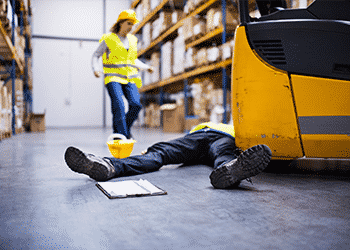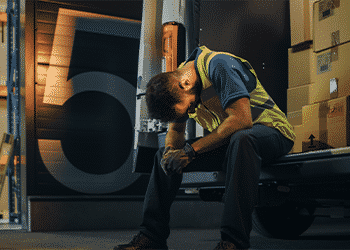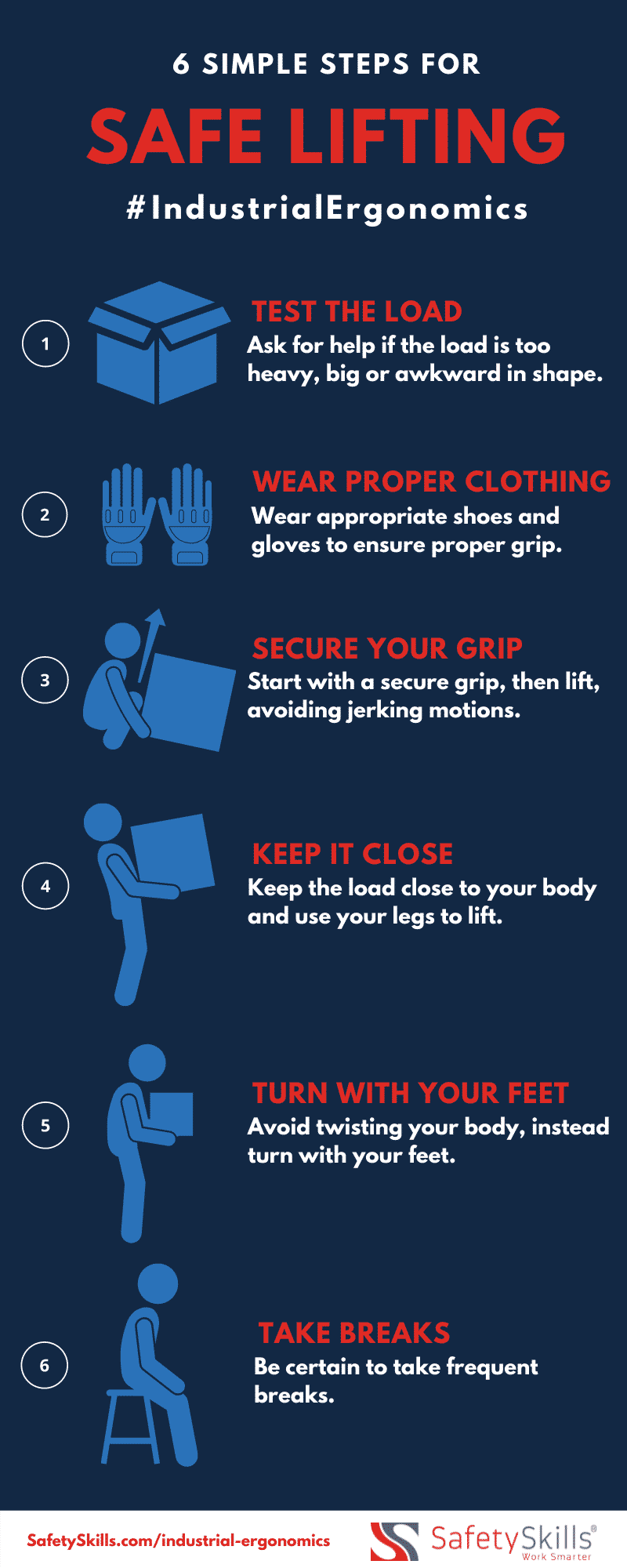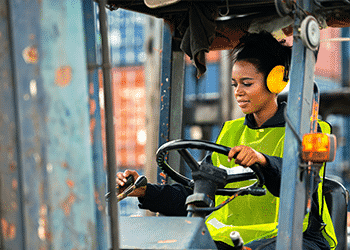While in recent years, there has been a significant increase in the number of warehouse employees — reaching more than 1.4 million U.S. workers in 2021 — there has also been a rise in the number and size of new warehouses being built.
Both UPS and FedEx operate more than 35 million square feet of global warehousing space each, while Tesla and Amazon recently opened two of the largest single-building warehouses in the world: the Tesla Gigafactory 1 boasts 5.3 million square feet of floor space and Amazon’s MQY1 Fulfillment Center provides the company with 3.6 million square feet.
However, no matter what size the facility is or how many employees work there, warehouse employees can be exposed to many hazards and it is important to educate yourself on warehouse safety to protect your employees, your facility and your organization.
Worker Injuries and Warehouse Violations
It will likely not surprise you to learn that warehouses are among the top sites of worker injuries each year. In 2020, the worker injury rate within transportation and warehousing was 4.0 per 100 full-time workers, third only to the healthcare and agriculture, forestry, fishing and hunting industries.

Among those injuries, almost 55% were sprains, strains or fractures. These types of injuries are often the result of preventable accidents that can be avoided with employee training or perhaps simply more employee — or management — attention and care.
In addition to a high rate of injuries, the warehousing and storage industry was hit with more than $800,000 in OSHA violations during fiscal year 2021 (October 2020-September 2021). The top five most costly citation categories were as follows:
- Powered industrial trucks, $285,545 in fines
- OSH Act General Duty Clause, $71,662 in fines
- Materials handling and storage, $51,780 in fines
- General machinery and machine guarding, $49,930 in fines
- Exit routes, $47,480 in fines
More than a quarter of all warehousing violations in the past year came about from inspections that resulted in multiple citations. When companies fail to maintain OSHA compliance, they not only risk potentially massive penalties, but they also put all of their employees in danger each and every day.
Looking for more online safety training courses?
Job Demands Create Injury Potential
The warehousing industry inherently comes with employee safety hazards, but recent developments outside the physical danger of the workplace are contributing to current — and potentially future — warehouse injuries.
Supply Chain Shortages
There are many technological reasons for current supply chain issues, including a global computer chip shortage, but the human factor is also creating problems. Large numbers of Baby Boomers reaching retirement age combined with fewer high school or college graduates choosing warehousing as a career leaves gaps in warehouse staffing, especially at the middle management level.
COVID-19
Starting in early 2020, when millions of Americans were forced to work from home and were often quarantined in place for some time, e-commerce saw massive gains. An online sales boom meant more employees were needed to process orders. And more often than not, more employees increases the chances of workplace injuries.

Employee Fatigue
While the early days of the COVID-19 pandemic created an increased need for workers, in mid-2021, employees were ready for a change. Something known as the Great Resignation saw millions of workers — 4.3 million in August alone — quit their jobs, meaning those left behind were saddled with more responsibility and longer hours. In a physical industry like warehousing, this creates employee fatigue and wildly increases the likelihood of incidents.
Inadequate Training
As employee numbers fluctuate, and experienced workers retire or resign early, employee training often suffers. Initial training is likely done to get new employees up to speed, but continued training benefits every employee at every level. After all, workers not only need to stay up-to-date with regulations, but also must know how to follow all preventive and reactive steps in various situations, making it imperative they fully understand the training.
Manual Lifting

Back injuries are one of the most common workplace injuries among all industries. In warehouses, they usually come from improper lifting techniques. Improper lifting or twisting while carrying a heavy load can lead to sprains, strains, torn muscle, torn cartilage, and displaced or compressed vertebrae. The more repetitive lifting your employees do, the more at risk your employees are for back injury.
Mechanical lifting methods, such as a pallet jack or dolly, should be available wherever possible. However, in case they are not available, you should train your employees on ways to reduce the risks of a manual lift.
Safe manual lifting practices include:
- Planning lifts before getting started
- Checking the load for information tags
- Using the handles on the load or adding some if not already available
- Testing the load’s stability and weight
- Asking for assistance if the load is too heavy or awkward for one person
- Wearing gloves and long sleeves to protect hands and forearms
- Bending your knees to lower yourself in front of the item, instead of bending your back
- Keeping the load between your chest and your knees
Material Lifting
Properly storing materials is important in reducing the risk of multiple hazards including slips, trips and falls, fire, and dropped objects. To prevent materials from falling, they should be stacked evenly, in a straight line and according to weight, with the heaviest materials on the bottom. You should train your employees to only remove items from a shelf one by one as carrying multiple objects at a time can cause injuries.
Loose materials should be stored in a way that prevents the pile from falling. This can be done by blocking, interlocking or limiting the height of the pile. All materials should be stored in a way that helps prevent fire hazards, explosions or pest infestation.
Loading docks are places with many hazards, including forklifts, trucks, heights and heavy lifting. Open loading dock doors should be blocked off when not in use and the edges of the dock should have visual warnings. Everyone should always use the dock ladder or stairs; never jump or attempt to climb up a loading dock.
Safety Involves Mental Health, Too
According to the National Institute of Mental Health, nearly one in five U.S. adults suffered from some type of mental illness in 2019, and the numbers have not improved since COVID-19 hit the United States in January 2020 and thrust millions of Americans into isolation, unemployment and illness.
In recent years, numerous studies have been conducted on mental health in adults, with most seeming to focus on millennials (25-40 years old in 2021) and the adult segment of the Gen Z generation (18-24 years old). However, studies have found that every working generation suffered from a mental health issue during the pandemic (71% of Gen Zers, 59% of millennials, 36% of Gen Xers and 22% of baby boomers).
Of course, every organization will have their own mental health-related issues to address, due to different company sizes, industries, jobsite setups and employee demographics. The best thing you can do is talk to your employees. Find out what their concerns are, work together to come up with solutions and be open in continuing discussions.
Remember that mental health awareness should — without question — be part of your workplace culture and can easily be tied into any safety program.
Mechanical Material Handling Equipment

Providing your employees with mechanical equipment to help them lift heavy or bulky objects can speed up the process and reduce the risk of back and other injuries, but mechanical equipment is not without its own risks. Forklifts alone caused more than 8,100 injuries and 75 deaths in 2019.
“Forklift” is a term commonly used for a group of vehicles that OSHA classifies as powered industrial trucks, or PITs. The most common types of PITs are electric and internal combustion engine rider trucks. Narrow aisle trucks, forklift tractors, motorized pallet jacks and rough terrain forklifts all classify as powered industrial trucks.
If your employees will be using a forklift or other PIT as part of their job duties, you need to train them over the specific machine they will be using, its controls and hazards, and any specific hazards that exist in your workspace.
Almost all pieces of lifting equipment involve pinch-point hazards, while cranes create overhead, struck-by and dropped-object hazards. Before allowing employees to use any equipment, you should properly train them and make sure they always follow manufacturer instructions.
Hazcom Safety
If your warehouse has chemicals or compressed gases present, each chemical should have a Safety Data Sheet (SDS) associated with it. The SDS will tell you how to handle and store that chemical. Even with the help of an SDS, employees should never attempt to use, handle or clean up a chemical unless they have had additional training on its use.
You should have an emergency plan in place that outlines who should do what in an emergency. Be sure your employees understand the contents of the emergency plan before a situation arises. The plan should include emergency exit locations, evacuation procedures, and the location of fire extinguishers and other emergency equipment. It should also include methods for ensuring the safety of all visitors.
To reduce the risk of fires, flammable and explosive materials must be stored in appropriate storage areas away from other materials and sources of ignition. Chemicals should be stored according to manufacturer recommendations and relevant fire codes. Smoking and open flames should be prohibited in battery charging or compressed-gas storage areas.
Partner for Employee Safety
Warehouses are a necessity in many industries but they do come with their own risks, including hazardous substances, heavy machinery and potentially dangerous locations within the warehouse itself. See how SafetySkills can help you create a safety training plan to help protect your workers and your organization.


